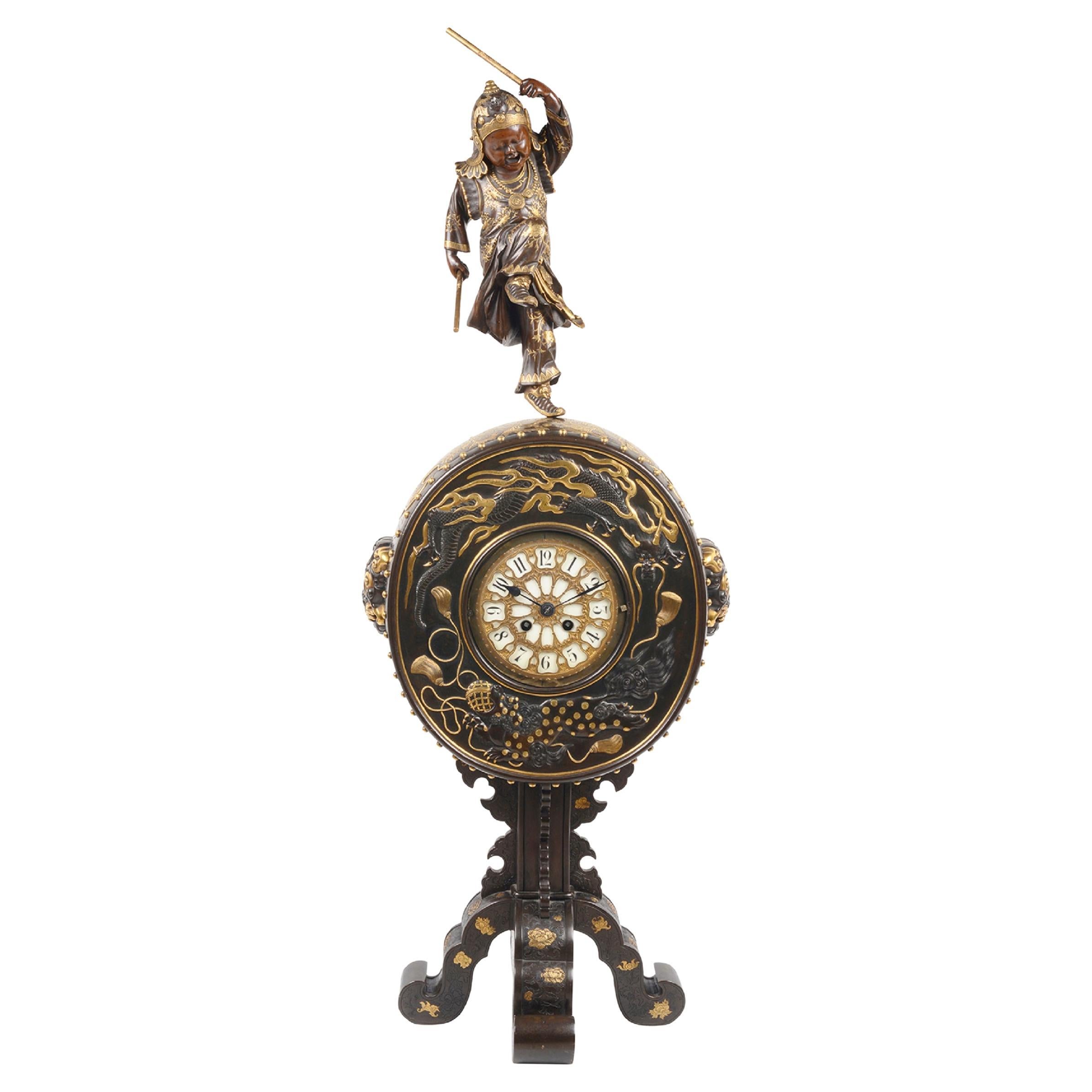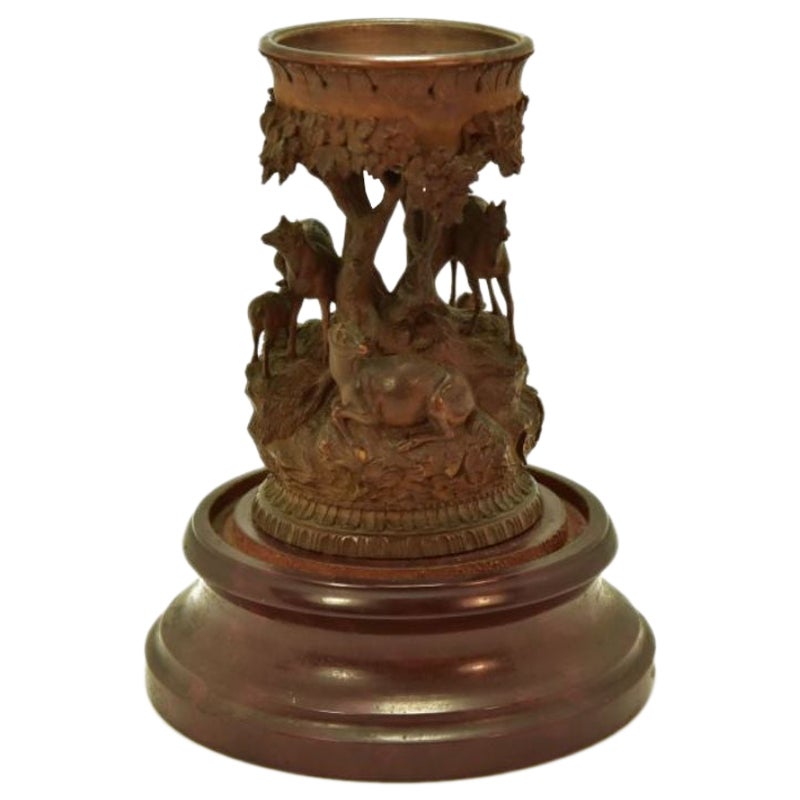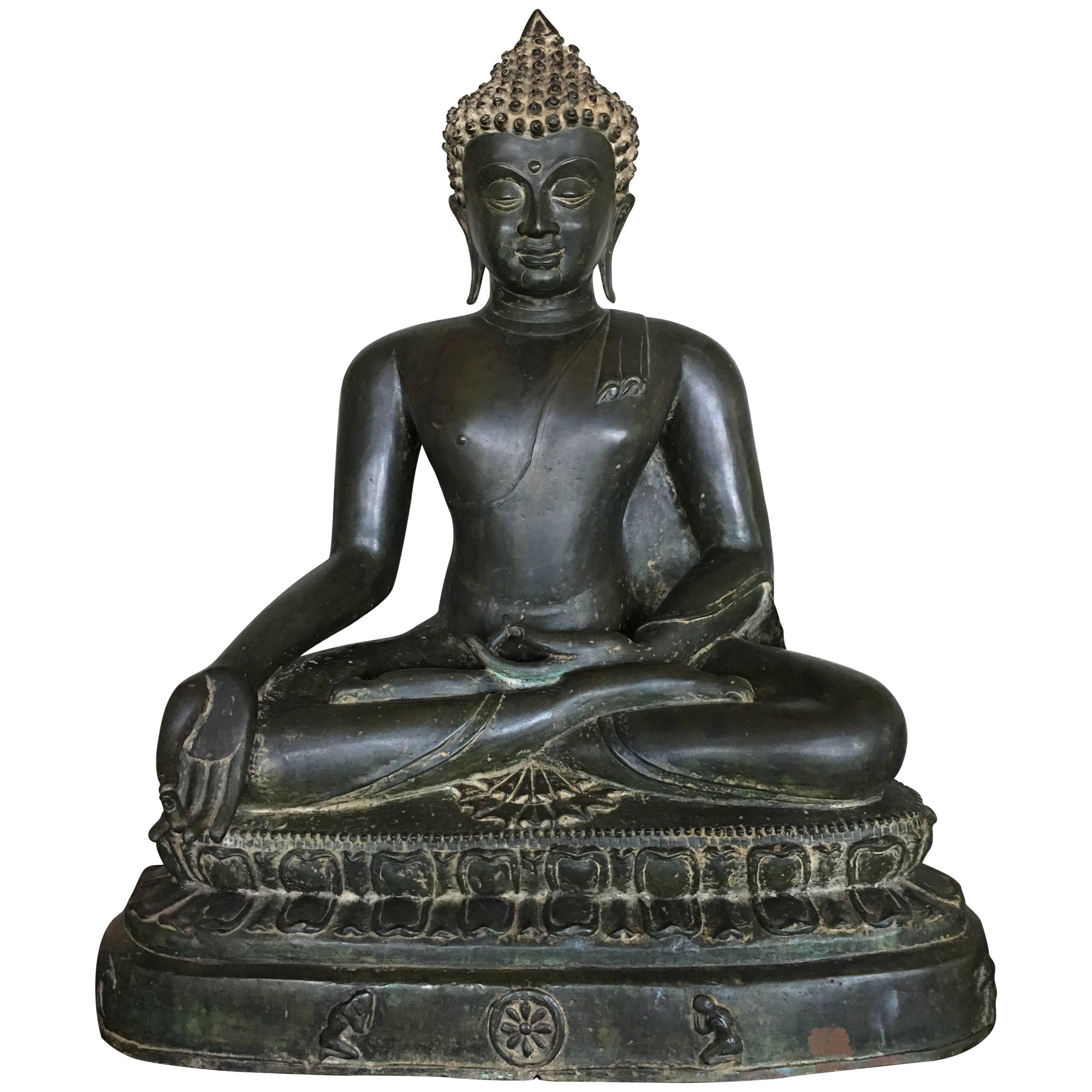Items Similar to Large 19th Century French Ormolu Clock Garniture in the Louis XVI Style
Want more images or videos?
Request additional images or videos from the seller
1 of 8
Large 19th Century French Ormolu Clock Garniture in the Louis XVI Style
About the Item
Measures: H: 25 1/2 in / 64.7 cm ; W: 22 1/4 in / 56.5 cm ; D: 9 1/2 in / 24.2 cm
An exceptional quality three-piece clock set designed in a grand neoclassical.
The set is comprised of a central clock and two flanking candelabra. The clock features a circular dial, which is inscribed with Roman Numerals. The dial is contained within a gilt bronze (ormolu) case, which is topped by classical cornucopias and a twin-handled vase. The clock case is set on a gilt bronze waisted plinth with a laurel leaf edge, and flanked by two gilt bronze acanthus leaf scrolls, which are draped with foliage swags. The clock is set on a gilt bronze rectangular base, which is decorated with a central scrolled foliate panel, edged with laurel leaves, and set on five toupie feet.
The pair of flanking gilt bronze candelabra are designed in a similar style to the clock. Each candelabrum features five lights, one of which is positioned directly above the stem, the other four scrolling up around it. The lights terminate in leafy drip-pans and urn-shaped capitals. The lights are supported on classical vases, which are set on plinths, flanked by scrolls and hung with foliage swags. The candelabra stand on rectangular bases, with decorative front mounts, raised up on four toupie feet.
circa 1880
French
Measures:
Clock: height 64.7 cm; width 56.5 cm; depth 24.2 cm
Candelabra: height 70 cm; width 27 cm; depth 19 cm.
- Dimensions:Height: 25.48 in (64.7 cm)Width: 22.25 in (56.5 cm)Depth: 9.53 in (24.2 cm)
- Style:Louis XVI (In the Style Of)
- Materials and Techniques:
- Place of Origin:
- Period:
- Date of Manufacture:1880
- Condition:Wear consistent with age and use.
- Seller Location:Dublin, IE
- Reference Number:1stDibs: LU5735232825332
About the Seller
5.0
Vetted Seller
These experienced sellers undergo a comprehensive evaluation by our team of in-house experts.
Established in 2006
1stDibs seller since 2021
7 sales on 1stDibs
Typical response time: 6 hours
- ShippingRetrieving quote...Ships From: Dublin, Ireland
- Return PolicyA return for this item may be initiated within 3 days of delivery.
More From This SellerView All
- 19th Century Antique French Neoclassical Style Gilt Bronze Clock GarnitureLocated in Dublin, IEAn exceptional quality three-piece clock set designed in a grand neoclassical style by 'Domange Rollin Rue de Bretagne Paris'. France. The set is comprised of a central clock and tw...Category
Antique 19th Century French Louis XVI Mantel Clocks
MaterialsEnamel, Ormolu
- 19th Century French Louis XV Rococo Style Ormolu & Porcelain Mantle ClockLocated in Dublin, IEA very fine and most attractive 19th century French Louis XV Rococo Style ormolu and porcelain mantle clock, modelled as an urn with floral finial and goat head masks to the sides, o...Category
Antique 19th Century French Louis XV Mantel Clocks
MaterialsOrmolu
- 19th Century French Clock Garniture By Prosper Roussel Of ParisLocated in Dublin, IEA stunning ormolu and onyx mantle clock with garniture. Surmounted by a seated cupid on a octagonal shaped base with a wreath border, twin barrel movement striking on a bell ,an enamel dial with the hours and minutes in Roman numerals respectively, the dial signed Prosper Roussel...Category
Antique 19th Century French Victorian Mantel Clocks
MaterialsOnyx, Ormolu
- 19th Century French Ormolu Centre Piece in the Louis XVI StyleLocated in Dublin, IEAn exceptional quality 19th century Ormolu centre piece in the Louis XVI style. The shallow lobed ogee bowl shaped receiver with lappest cast deep rim below a fluted swept top with l...Category
Antique 19th Century French Louis XVI Urns
MaterialsOrmolu
- Early 19th Century French Sienna Marble Mantle ClockLocated in Dublin, IEAn exceptional quality early 19th century Sienna marble and ormolu mantle clock, the sienna marble case surmounted by an urn, raised on ormolu bun feet and a rectangular plinth steep...Category
Antique Early 19th Century French Restauration Mantel Clocks
MaterialsSiena Marble, Ormolu
- 19th Century French Louis XVI Style Chinoserie & Ormolu Mounted Side CabinetLocated in Dublin, IEA very fine French ormolu-mounted chinoserie black and gold lacquer pewter-inlaid ebony side cabinet of very neat proportions, with a rectangular black marble top above a decorated o...Category
Antique 19th Century French Louis XVI Cabinets
MaterialsMarble, Ormolu
You May Also Like
- Art Deco Style Chinoiserie Mantel Clock w. Handpainted Males, Females and DragonLocated in Lisse, NLHandcrafted and rare, Asian style, hand-painted & gilt table, desk or mantel clock. This rare combination-of-styles clock is in good condition, in perfect working order and a joy to...Category
Early 20th Century French Japonisme Mantel Clocks
MaterialsBrass
- Large Elaborately Carved Chinese Style Frame, France, 19th CenturyLocated in Isle Sur La Sorgue, VaucluseAn unusual and beautifully-carved wood frame. The carvings are in relief, so that the frame is quite deep. Original, ochre-yellow color. The piece has acquired a nice patina.Category
Antique 19th Century French Picture Frames
MaterialsWood
- Fine Japanese Miyao Bronze Mantel ClockBy Eisuke Miyao 1Located in Brighton, SussexA fine quality and rare, Japanese Meiji period (1868-1912) Signed Miyao bronze mantel clock. Having a charming drummer boy above a drum like surround to t...Category
Antique Late 19th Century Japanese Mantel Clocks
MaterialsBronze
- Chinese Art Deco Carved Mahogany Mantle Clock, circa 1900Located in Nantucket, MATurn of the century Chinese carved mahogany mantle clock, circa 1900, an Art Nouveau to Art Deco transitional style with a period wind-up mechanical cl...Category
Early 20th Century Chinese Art Deco Mantel Clocks
MaterialsMahogany
- Wooden Object Carved with Deer in the 19th Century Black Forest StyleLocated in Marseille, FRObject in a bell jar, a sort of black forest style cup. Probably German or Austrian object from the 19th century. DPA Additional information: Material: Fruit woods.Category
Antique 19th Century More Asian Art, Objects and Furniture
MaterialsFruitwood
- Large Burmese Bronze Medicine Buddha, Pagan Style, Late 19th CenturyLocated in Austin, TXA large and magnificent cast bronze image of the Medicine Buddha, Bhaisajyaguru, rendered in the Burmese Pagan style, and most likely based on a period example that was either damaged or lost, 19th century, Burma or Thailand. He can be identified as the Medicine Buddha by the hand that rests in his lap, with his middle finger touching the thumb. A medicine pot or fruit stem would originally have been placed in his upturned palm. The face of this Buddha has been sculpted masterfully. He has a beautiful heart shaped face topped by hair neatly arranged in the typical "snail shell curls", and surmounted by a high ushnisha. Long, pendulous earlobes frame his face, a symbol of his princely past. He gazes serenely outwards from heavily lidded, downcast eyes, a content smile upon his full, lush lips. The Buddha is portrayed seated in vajrasana (full lotus position), his elegant hands displayed in varada mudra, the gesture of granting favors and fulfilling wishes. Long, exquisite fingers extended, the thumb and middle finger touching in a gesture of compassion. He is clothed in a simple kasaya wrapped around his body and over one shoulder, leaving the shoulder and part of his chest bare. The diaphanous garment clings to his body, outlining his well proportioned and graceful, almost sensuous, form. The excess material pooled in neat pleats in front of him. A sash thrown over his shoulder. He sits upon a double lotus base upon a raised platform. The platform features two kneeling attendants, usually interpreted as the monks Ananda and Kasyapa. Between them is a circular disc representing the Wheel of Dharma. Contained in the disk is a flower with eight petals, symbolizing the eightfold path, one of the principle teachings of the Buddha. The sides and back of the platform featuring a series of singha, or lions, representative of the Buddha's royal past. An applied lacquer patina covers the entirety of the image. Large deposits of ash (from incense) are present between the curls of the hair, as well as some the other crevices, indicating this image was the subject of worship for many years. Bhaisajyaguru, also called the Medicine Buddha, or Buddha of Healing, is a revered figure in the Buddhist pantheon as a master able to cure suffering, both physical and spiritual, through his teachings. The Pagan Empire ruled most of present day Burma (Myanmar) from 849 to 1297. The capital, Bagan, served as a both the center of government and religion, where Buddhism reigned supreme. Bagan was also at a crossroads of the Buddhist world, with influence from India, Nepal, Tibet, China, and even Indonesia shaping their culture. As such, Pagan Buddha...Category
Antique Late 19th Century Burmese Sculptures and Carvings
MaterialsBronze
Recently Viewed
View AllMore Ways To Browse
Antique Set Design
The Terminator
Bronze Acanthus
Large French Louis Xvi
French Louis Xvi Style 19th Century Large
Rectangular Bases
Large French Clock
2 Antique Clocks
Toupie Antique
French Gilt Clock Louis Xvi
Clock Clock 9
Leaves Clock
French Candelabra Clock
Louis Xvi Style Clock
Ormolu Clock Set
Classical French 19th Century Louis Xvi Style
Louis Xvi Ormolu Clock
Antique Mantel Vases





